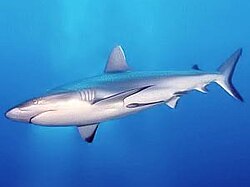Portal:Sharks
Welcome to the shark portal

Sharks are a group of elasmobranch cartilaginous fishes characterized by a ribless endoskeleton, dermal denticles, five to seven gill slits on each side, and pectoral fins that are not fused to the head. Modern sharks are classified within the division Selachii[page needed] and are the sister group to the Batomorphi (rays and skates). Some sources extend the term "shark" as an informal category including extinct members of Chondrichthyes (cartilaginous fish) with a shark-like morphology, such as hybodonts. Shark-like chondrichthyans such as Cladoselache and Doliodus first appeared in the Devonian Period (419–359 million years), though some fossilized chondrichthyan-like scales are as old as the Late Ordovician (458–444 million years ago). The earliest confirmed modern sharks (Selachii) are known from the Early Jurassic around 200 million years ago, with the oldest known member being Agaleus, though records of true sharks may extend back as far as the Permian.
Sharks range in size from the small dwarf lanternshark (Etmopterus perryi), a deep sea species that is only 17 centimetres (6.7 in) in length, to the whale shark (Rhincodon typus), the largest fish in the world, which reaches approximately 12 metres (40 ft) in length. They are found in all seas and are common to depths up to 2,000 metres (6,600 ft). They generally do not live in freshwater, although there are a few known exceptions, such as the bull shark and the river sharks, which can be found in both seawater and freshwater, and the Ganges shark, which lives only in freshwater. Sharks have a covering of placoid scales (denticles) that protects the skin from damage and parasites in addition to improving their fluid dynamics. They have numerous sets of replaceable teeth.
Several shark species are apex predators, which are organisms that are at the top of their food chain with select examples including the bull shark, tiger shark, great white shark, mako sharks, thresher sharks and hammerhead sharks. Some sharks are filter-feeding planktivores, such as the whale shark and basking shark, which are among the largest fish ever lived. (Full article...)
Selected article -
Nocturnal animals, tawny nurse sharks tend to spend the day resting in piles of two dozen or more individuals inside caves or under ledges. At night, they are active-swimming predators that use a powerful suction force to extract prey from inside holes and crevices. The diet of the tawny nurse shark consists mainly of octopus, though they also take other invertebrates, small bony fishes, and rarely sea snakes. This species is ovoviviparous, meaning the embryos hatch from egg capsules inside the mother. It is the only carpet shark in which the embryos are oophagous, feeding on eggs produced by the mother while inside the uterus. The litter size may be as small as one or two, based on the large size of near-term embryos.
Compared to the nurse shark, the tawny nurse shark has a more placid disposition and will often allow divers to touch and play with it. However, it should be accorded respect due to its powerful jaws and sharp teeth. This species is caught by commercial fisheries across most of its range for meat, fins, liver oil, leather, and fishmeal. It is also esteemed as a game fish off Queensland, Australia, and is known for its habit of spitting water in the faces of its captors. The World Conservation Union has assessed this species as Vulnerable.
Did you know (auto-generated)

- ... that Hixxy and Sharkey created a schism in the UK rave music scene in 1995?
- ... that a shark cost a competitor a silver medal in the spearfishing event at the 2014 Micronesian Games?
- ... that the parasitic copepod Driocephalus cerebrinoxius burrows into the brains of sharks through their noses?
Categories
Related portals
WikiProjects
Selected picture -

More Did you know? -
- ... that male Arabian carpetsharks competing for a mate have been known to bite the claspers of their rivals?
- ... that the porbeagle has been known to "play" with kelp fronds, pieces of wood, and fishing floats?
- ... that the blind shark and the bluegrey carpetshark close their eyes when taken out of the water?
- ... that male Arabian carpetsharks competing for a mate have been known to bite the claspers of their rivals?
- ... that the whitefin, Cook's, Australian reticulate, spotted, leopard-spotted, painted, flagtail, speckled, saddled, and narrowbar swellsharks were all scientifically described in 2008, more than doubling the number of species in the genus Cephaloscyllium?
General images
Topics
For additional lists of marine life-related featured articles and good articles see:
Wikimedia
The following Wikimedia Foundation sister projects provide more on this subject:
-
Commons
Free media repository -
Wikibooks
Free textbooks and manuals -
Wikidata
Free knowledge base -
Wikinews
Free-content news -
Wikiquote
Collection of quotations -
Wikisource
Free-content library -
Wikispecies
Directory of species -
Wikiversity
Free learning tools -
Wiktionary
Dictionary and thesaurus






































